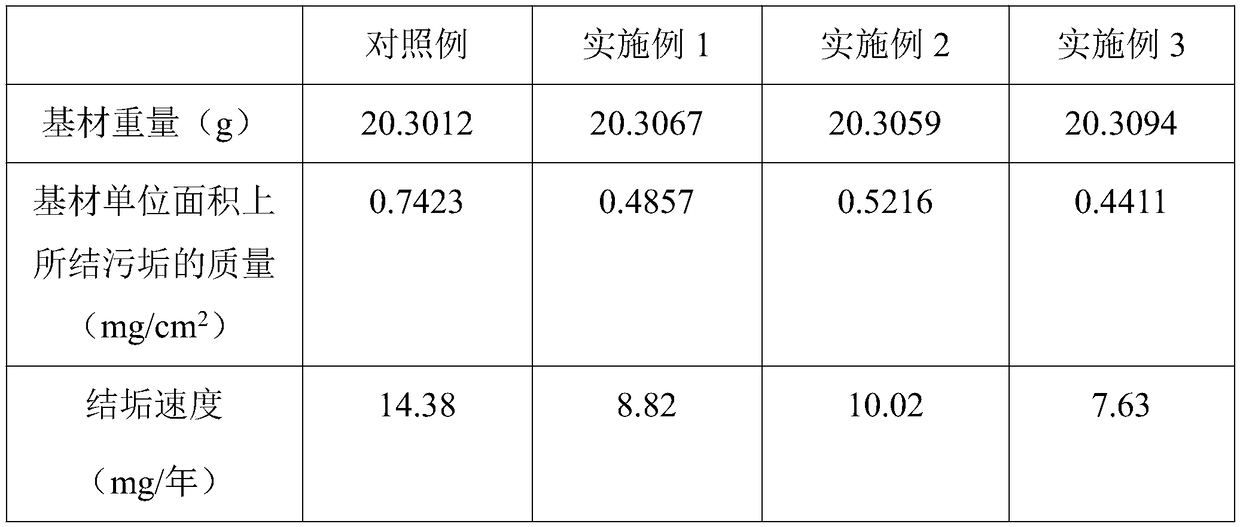Composite slow-release scale inhibitor
A scale inhibitor and slow-release technology, applied in the field of scale inhibitor, can solve the problems of poor scale inhibitor effect, too fast digestion of scale inhibitor, good anti-hydrolysis performance, etc. Good hydrolysis performance
- Summary
- Abstract
- Description
- Claims
- Application Information
AI Technical Summary
Problems solved by technology
Method used
Image
Examples
Embodiment 1
[0022] A composite slow-release antiscalant, according to parts by weight, including the following raw materials:
[0023] 23 parts of polyepoxysuccinic acid, 14 parts of polyacrylic acid, 8 parts of hydrolyzed maleic anhydride, 13 parts of modified chitosan, 5 parts of sodium gluconate, 2 parts of lauryl monoethanolamine and 28 parts of water.
[0024] The degree of substitution of the modified chitosan is 70%, and its preparation method comprises the following steps:
[0025] 1) Dissolving chitosan in a mass concentration of 5% malonic acid aqueous solution is prepared into chitosan malonic acid aqueous solution;
[0026] 2) Heat chitosan-malonic acid aqueous solution to 60°C in a water bath, while stirring for 30 minutes;
[0027] 3) adding dimethylaminoethyl acrylate to the chitosan malonic acid aqueous solution in step 2), after reacting for 6 hours, cooling to room temperature to obtain the reaction product;
[0028] 4) Recrystallize the reaction product, and then dry ...
Embodiment 2
[0031] A composite slow-release antiscalant, according to parts by weight, including the following raw materials:
[0032] 20 parts of polyepoxysuccinic acid, 12 parts of polyacrylic acid, 10 parts of hydrolyzed maleic anhydride, 10 parts of modified chitosan, 6 parts of sodium gluconate, 1 part of fatty alcohol polyoxyethylene ether and 30 parts of water.
[0033] The degree of substitution of modified chitosan is 85%, and its preparation method comprises the following steps:
[0034] 1) dissolving chitosan in a mass concentration of 8% malonic acid aqueous solution is prepared into chitosan malonic acid aqueous solution;
[0035] 2) Heat chitosan-malonic acid aqueous solution in a water bath to 70°C while stirring for 20 minutes;
[0036] 3) adding dimethylaminoethyl acrylate to the chitosan malonate aqueous solution in step 2), after reacting for 3h, cooling to room temperature to obtain the reaction product;
[0037] 4) Recrystallize the reaction product, and then dry th...
Embodiment 3
[0040] A composite slow-release antiscalant, according to parts by weight, including the following raw materials:
[0041] 25 parts of polyepoxysuccinic acid, 16 parts of polyacrylic acid, 6 parts of hydrolyzed maleic anhydride, 15 parts of modified chitosan, 3 parts of sodium gluconate, 3 parts of lauryl glucoside and 25 parts of water.
[0042] The degree of substitution of modified chitosan is 60%, and its preparation method comprises the following steps:
[0043] 1) Dissolving chitosan in a mass concentration of 3% malonic acid aqueous solution is prepared into chitosan malonic acid aqueous solution;
[0044] 2) Heat chitosan-malonic acid aqueous solution in a water bath to 62°C while stirring for 28 minutes;
[0045] 3) adding dimethylaminoethyl acrylate to the chitosan malonate aqueous solution in step 2), after reacting for 3.6h, cooling to room temperature to obtain the reaction product;
[0046] 4) Recrystallize the reaction product, and then dry the crystallized pr...
PUM
| Property | Measurement | Unit |
|---|---|---|
| degree of substitution | aaaaa | aaaaa |
| degree of substitution | aaaaa | aaaaa |
| degree of substitution | aaaaa | aaaaa |
Abstract
Description
Claims
Application Information
 Login to View More
Login to View More - R&D
- Intellectual Property
- Life Sciences
- Materials
- Tech Scout
- Unparalleled Data Quality
- Higher Quality Content
- 60% Fewer Hallucinations
Browse by: Latest US Patents, China's latest patents, Technical Efficacy Thesaurus, Application Domain, Technology Topic, Popular Technical Reports.
© 2025 PatSnap. All rights reserved.Legal|Privacy policy|Modern Slavery Act Transparency Statement|Sitemap|About US| Contact US: help@patsnap.com

